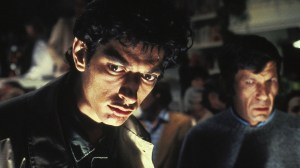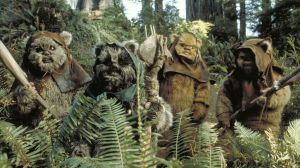On Friday, The Lord of the Rings: The Rings of Power debuted the final episode of its first season, which revealed Sauron’s secret identity (SPOILERS follow for The Lord of the Rings: The Rings of Power Episode 8, “Alloyed”). It turns out that Halbrand (Charlie Vickers), supposed king of the Southlands, has been Sauron in disguise all along. Galadriel (Morfydd Clark) discovers this by researching the history of the Southlands’ royal line, discovering it ended 1000 years earlier. Sauron reveals himself to Galadriel, claiming to be penitent while also tempting her to join him as his queen ruling Middle-earth. Galadriel rebukes Sauron, but by the time she breaks his sway, Sauron has vanished. However, he already provided the great Elven smith Celebrimbor with the knowledge needed to forge the Three Rings. With the light of the Valar fading, the Elves have little choice but to go ahead with their plans, and thus the Three Rings are created.
Videos by ComicBook.com
How do these events compare to what we know of Middle-earth’s history from J.R.R. Tolkien’s writings? The Rings of Power follows a different path but visits many of the same narrative landmarks.
Sauron in the First Age
According to Tolkien’s writing, Sauron served as Morgoth’s lieutenant during much of the First Age. That ended when the Elves defeated Sauron on the Isle of Werewolves.
After his defeat, Sauron disappeared for a time, likely avoiding Morgoth’s disappointed wrath. He only emerged again after his master’s defeat.
Sauron Repentant
When Sauron did emerge, he pleaded for mercy from the Elvish forces who vanquished Morgoth, claiming he regretted his actions. However, he did not regret his actions enough to face judgment and punishment for his deeds, instead fleeing into hiding in Middle-earth. Whether his regrets were ever sincere is unclear, as they are unclear in The Rings of Power. We asked writer Gennifer Hutchison what fans should make of Halbrand claims that he is trying to fix things.
“I think we really did want that to feel open to interpretation, very specifically, as we were going through the season and building his character and his storyline,” she said. “Because if you do go back, we wanted him to be internally consistent for both Halbrand and Sauron. And even in the room, we would go back and forth. Is he being sincere? Is this part of a manipulation? And I think part of the beauty of a character like Sauron and this situation is that it really is how you read it. And I would love for fans to be able to bring their own interpretation to that. Obviously, I think the actor has his own. We all have our own feeling. Is it genuine or not? And I think that’s a little bit of the beauty of it is it could really go either way.”
Sauron in Disguise
Sauron only emerged once more to put his plan for the One Ring into motion. Upon reemerging, he took on the guise of Annatar, Lord of Gifts, and sought to corrupt the Elves into his service. Tolkien’s writings find Sauron befriending Celebrimbor and teaching him how to make magic rings, as occurs in The Rings of Power.
Whether we will see the Annatar persona in The Rings of Power at some point remains to be seen. For now, Sauron’s Halbrand persona seems to be taking its place, used to insert himself into the affairs of the Elves and influence them towards creating The Three Rings. Halbrand shares his knowledge of alloys with Celebrimbor and calls it a “gift,” which appears to be a reference to the “Lord of Gifts” for the Tolkien fans in the audience.
The Forging of the Rings
While Sauron does focus his efforts first on the Elves, the Three Rings are the last to be forged in Tolkien’s writings. Celebrimbor only creates the Three after Sauron (as Annatar) has left to bring the Seven to the Dwarves and the Nine to Men. Thus, they were free from Sauron’s corrupting influence, though still bound to the One Ring through the arts the Dark Lord taught Celebrimbor. Once the Elves discover Sauron’s influence over them, they remove the Three and send them into hiding, leading to war with Sauron. After Sauron’s defeat at the end of the Second Age, the Elves wear the Three Rings again during the Third Age to preserve their forests.
The Rings of Power goes in a different direction, presenting the Three as being forged first, perhaps as prototypes for the other Rings to come. We don’t know if The Rings of Power will treat the Three differently than the other 16 rings, either because Sauron departed Eregion before their forging or because they were a test. However, as Hutchison told us, “I think this [Season 1] storyline, really, was about the Three Rings. All I’ll say is there are more rings to be made.”
Sauron in Mordor
Sauron in The Rings of Power ends up where he begins in Tolkien’s telling: Mordor. In the books, by the time Annatar began offering his gifts, Sauron had established himself in Mordor and began amassing armies.
But The Rings of Power‘s first season served, in part, as an origin story for Mordor, which came into existence through the efforts of Adar and his Orcs. They did this by setting off the volcano that will eventually be known as Mount Doom, where Sauron will forge the One Ring. The Rings of Power’. “Well, leaving the world’s state as it is — as you said, Adar and his Orcs have created Mordor; Sauron has crested the rise into it — obviously, those are storylines that have been left open at the end of the season,” Hutchison said in our interview. “So I would say it’s safe to assume that there will be more exploration in that world as we go forward.”
The Lord of the Rings: The Rings of Power is streaming now on Prime Video. Its second season is in production.








